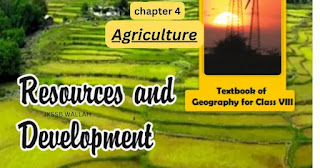Agriculture
1. Answer the following questions.
(i) What is agriculture?
Ans: Agriculture is a primary activity that involves growing crops, vegetables, fruits, flowers, and raising livestock. It is directly linked to extracting and producing natural resources.
(ii) Name the factors influencing agriculture.
Ans: Factors influencing agriculture include soil, climate, topography, and population, among others.
(iii) What is shifting cultivation? What are its disadvantages?
Ans: Shifting cultivation, also known as slash-and-burn agriculture, is a farming method where farmers clear land by cutting and burning vegetation. They grow crops on the cleared land for a few years and then move to a new plot.
Disadvantages of shifting cultivation:
1. Environmental Impact: Deforestation and loss of biodiversity due to burning and clearing land.
2. Soil Degradation: Soil fertility declines over time, leading to reduced crop yields.
3. Land Conflicts: As populations grow, there is less land available for this practice, causing disputes.
4. Unsustainable: Not suitable for the growing population, leading to land degradation.
5. Limited Crop Variety: Few crops can be grown, reducing dietary diversity and economic opportunities.
(iv) What is plantation agriculture?
Ans: Plantations are commercial farms cultivating single crops like tea, coffee, rubber, etc. They require ample labor, capital, and transportation networks. Major plantations are found in tropical regions like Malaysia, Brazil, India, and Sri Lanka.
(v) Name the fibre crops and name the climatic conditions required for their growth.
Ans: Jute and cotton are fibre crops. Jute requires high temperature, heavy rainfall, and high humidity, while cotton needs high temperature, light rainfall, and bright sunshine for growth.
2. Tick the correct answer.
(i) Horticulture means
(a) growing of fruits and vegetables
(b) primitive farming
(c) growing of wheat
(ii) Golden fibre refers to
(a) tea
(b) cotton
(c) jute
(iii) Leading producers of coffee
(a) Brazil
(b) India
(c) Russia
3. Give reasons.
(i) In India, agriculture is a primary activity.
Ans: Agriculture is a primary activity in India due to fertile land. Two-thirds of the population depends on agriculture due to low literacy. Large-scale food production is required to meet the needs of the densely populated country.
(ii) Different crops are grown in different regions.
Ans: Crops are grown in different regions based on several factors, including favorable soil topography, demand for produce, climate type, rainfall amount, technology, and available labor.
4. Distinguish between the following.
(i) Primary activities and tertiary activities
Ans:
| Primary Activities | Tertiary Activities |
|---|---|
| Production and extraction of natural resources, e.g., fishing, agriculture, mining. | Support to primary and secondary sectors, e.g., transportation, banking, etc. |
| Directly involved in resource extraction and production. | Provide services and support to other sectors. |
| Examples: Farming, fishing, forestry, mining. | Examples: Transportation, banking, insurance, tourism. |
(ii) Subsistence farming and intensive farming.
Ans:
| Subsistence Farming | Intensive Subsistence Farming |
|---|---|
| Farming for meeting family needs. | Cultivating small plots with simple tools and more labor. |
| Crops grown for personal consumption. | Rice, wheat, maize, pulses, and oilseeds are common crops. |
| Involves low levels of technology. | Prevalent in densely populated monsoon regions. |
| Output is small due to household labor. | Focuses on producing enough for family sustenance. |

